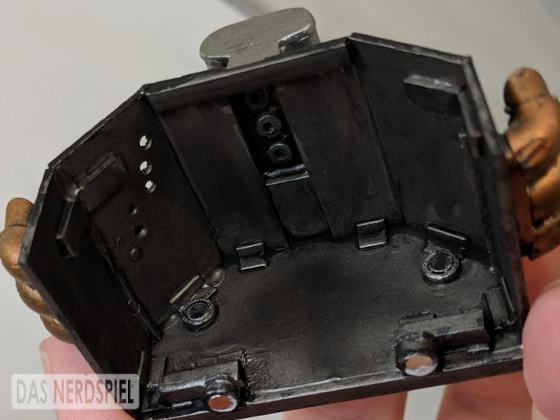The first gubbinz that I started working on after our mini-campaign were also the last ones that I managed to finish. My reinforced ram, though fairly simple conceptually, ended up being much more difficult to pull off that I had expected. The idea was simple enough. I was going to start from a Chimera dozer blade and bulk it out with Orky bits until it looked less functional as a plow and more like something that was just used to smash into things. I was envisioning something like the Battlewagon ram, but a bit more boxy. Simple, right?
The first few steps went very smoothly. I glued the dozer blade to the trunnion and then carefully cut across the push frame where it would meet the undercarriage of the trakk. I then drilled out both sides and inserted some sturdy brass rod into the blade side. Since this would be sticking out in front of the trakk and could be relatively large compared to some of my other gubbinz, I wanted to make sure that it didn't snap off if it got caught on a piece of terrain or something. To make it secure, however, I couldn't just have a strong connection between the blade and the frame, I also had to have a strong bond between the push frame and the undercarriage of the trakk. While there are lots of bits under there that I could have potentially glued the ram to, there were no flat surfaces where I could get a good bond. Just lots of bolts and rods, all at different depths. I decided that the best move would be to gently clip away a bit of the detail to make some flat, level places where I could attach the ram...
...I didn't do such a great job. I ended up accidentally breaking the front axle of my trakk. Then, while trying to clean up that mess, I ended up breaking some other bits off the undercarriage.
By the time I got all the broken bits removed and everything smoothed off, the entire front of the trakk was gone up to the chassis. While this was pretty frustrating, it meant that I could make the new undercarriage solid.
The new axle assembly was built with two big plasticard I-beams on the bottom, which gave me a good surface to glue my ram to, even though they would run perpendicular to each other.
Unfortunately, I was never able to get all the bits of broken axle out of the resin wheels, so I just extended the axle wider and drilled new holes into the wheels to pin them with some brass rod. Despite my best efforts, I didn't drill the holes in the wheels very straight, so the wheels are now really crooked. On the other hand, I didn't assemble the rear treads very straight either (I'm really starting to dislike working with resin), so the vehicle has never really been able to sit flat, so I didn't worry too much about it.
Attaching the dozer blade to the new axle assembly went very smoothly.
The hard part would be attaching everything to the chassis. Even after chopping off all the little greebly bits, it still wasn't a perfectly level surface, so I leveled it off with some plasticard.
I actually drilled out four little holes in each side to try and pin the axle on, but trying to line up four tiny bits of wire proved to be way too difficult, so I just glued all the flat surfaces together and filled all the gaps with green stuff. I then glued more plasticard to the outside to reinforce the bond. I also made sure to paint the axle assembly before sticking it to the rest of the trakk, since there was no way I was going to be able to paint all those little crossbeams once they were attached.
So after two months of breaking things and trying to repair them, I had finally managed to get the Chimaera dozer blade attached to my trakk, which meant that it was finally time for the converting of the actual ram to begin.
The first step was bulking the ram up to a size that looked good on the trakk, which took a bit of trial and error, adding on plasticard and then cutting it back down. The next step was making it look proper orky.
I added a bunch of panels to look the finished ram look more cobbled together, then added some ork glyphs and some big toofy bits. I used a combination of plasticard and glass beads for the rivets, which was rather time consuming, but managed to tie the scratchbuilt bits to the dozer blade.
For the paint job, I decided that I'd first paint it up all bright, shiny and new, then weather the shit out of it to make it look like it'd been smashing through everything in the desert for months.
This meant painting a million thin coats of white over the black undercoat...
It wasn't the cleanest checkerboard pattern I've ever painted, but it was about to get beat to hell, so I didn't mind.
The finished paint job turned out pretty well. Lots of washes and thinned down brown paint. I painted the scratches to look like the ram scraped up a lot of sand and rocks between the teeth of the dozer blade. I think the finished effect turned out pretty decent.
So after two long years of work, my Morker Mob is finally finished. There are still a few things I'd like to go back to and fix, such as making the big gunz on all my vehicles interchangeable (and someone got the idea of making a bunch of bikes stuck in my head). For now though, I'm pretty happy with how Grizwoad and his mob have turned out, so it's time to move on to some other nerd projects.


















































